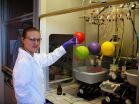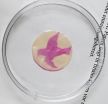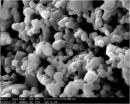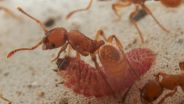(Press-News.org) The development of minimally and even non-invasive technologies is increasing in the medical field. It is now possible, for instance, to carry out a range of operative procedures using keyhole surgery with minimal use of the scalpel, leaving only tiny scars as a result. Similar opportunities are now becoming available when providing doses of active agents to patients – instead of using injections or probes to deliver drugs, it will in future be possible to supply them via a plaster which continuously, gently and painlessly delivers the required dosage through the skin.
Drug-loaded plaster to counter the fear of injections
For some years now premature babies – "preemies" – have been given caffeine to prevent respiratory arrest. The dose of caffeine is supplied to the infant in the incubator via a tube or through injection, both of which represent additional stress for the still very sensitive child. On top of this, neither method allows the drug to be dosed in an optimal manner, since at the moment of delivery a peak in concentration occurs followed by a sometimes rapid drop in its value. An ideal dosage technique would be able to maintain a stable concentration over a period of several hours.
In a project carried out in collaboration with the University Hospital, Zurich, and financed by the Swiss National Science Foundation, Empa has now developed a plaster which delivers the active agent via a membrane. This can be simply stuck to the skin of the preemie, after which it will provide the tiny patient with a continuous transdermal dose of, say, caffeine for several hours, without stressing the child as an injection would have done.
Developed in the laboratory, tested at the University Hospital
The membranes developed at Empa change their properties when they are irradiated with UV light. A similar effect is seen in photochromic sunglasses, where silver-doped glass reacts to UV light by darkening. In the new medicinal membranes, however, another light-sensitive functional chemical group is active, so called spiropyrans. When activated, these make the membrane more permeable, so that the active agent is able to pass through it more rapidly, a capability which is retained for several hours. In the absence of UV irradiation, the membrane simply prevents the active agent from permeating through it, as the researchers report in a recently published study in the scientific journal «Advanced Functional Materials».
The ability to precisely control both the quantity of active agent delivered by the membrane and the duration of delivery was of essential importance in the development. The medical staff at the University Hospital of Zurich, who were involved in the project, believe that the new plaster has a good chance of market success, since the delivery rate can be exactly controlled and adjusted to suit individual requirements. It will, however, be some time before the tiny patients can enjoy the new technique as currently Empa is seeking a partner to take on production of the plaster on an industrial scale.
INFORMATION:
Literature reference
From Membrane to Skin: Aqueous Permeation Control Through Light-Responsive Amphiphilic Polymer Co-Networks, K. Schöller, S. Küpfer, L. Baumann, P. Hoyer, D. de Courten, R.M. Rossi, A. Vetushka, M. Wolf, N. Bruns, L.J. Scherer, Advanced Functional Materials, 2014, 24, 5194-5201, DOI: 10.1002/adfm.201400671
Gentle caffeine boost for premature babies
Light sensitive membranes deliver medication
2014-10-29
ELSE PRESS RELEASES FROM THIS DATE:
Evolution of competitiveness
2014-10-29
Virtually all organisms in the living world compete with members of their own species. However, individuals differ strongly in how much they invest into their competitive ability. Some individuals are highly competitive and eager to get access to high-quality resources, while others seem to avoid competition, instead making prudent use of the lower-quality resources that are left over for them. Moreover, the degree of competitiveness in animal and human societies seems to fluctuate considerably over time. A theoretical study published in "Nature Communications" this week ...
Ghrelin stimulates an appetite for drinking alcohol
2014-10-29
Philadelphia, PA, October 29, 2014 – Ghrelin is a hormone released by the stomach and it stimulates appetite and food intake. Alcohol is commonly viewed as a psychoactive substance that primarily affects brain function, but it is also a highly caloric food.
This knowledge, combined with findings from animal studies, led researchers to the hypothesis that ghrelin has the potential to stimulate alcohol craving.
Dr. Lorenzo Leggio and his colleagues tested this in humans and found that, as they had anticipated, alcohol craving was increased in heavy drinkers following ...
Where you live doesn't matter if you have heart disease, study finds
2014-10-29
TORONTO, ON, Oct. 28, 2014 — People living in rural areas are at no greater risk of dying from heart disease than their urban counterparts, according to a new study by researchers at Women's College Hospital and the Institute for Clinical Evaluative Sciences (ICES).
The study, the first to examine outpatient quality of care between urban and rural communities, counters existing research, which suggested gaps in care for those living in rural areas.
"Research has long suggested people with heart disease in rural areas are at a disadvantage when it comes to access ...
Genome sequenced of enterovirus D68 circulating in St. Louis
2014-10-29
Researchers at Washington University School of Medicine in St. Louis have sequenced the genome of enterovirus D68 sampled from patients treated at St. Louis Children's Hospital. Nationwide, the virus has spread rapidly in recent months and caused severe respiratory illness in young children, with some patients requiring hospitalization.
"Having the DNA sequence of this virus enables additional research," said senior author Gregory A. Storch, MD, the Ruth L. Siteman Professor of Pediatrics. "It can be used to create better diagnostic tests. It also may help us understand ...
CU Denver study says upgrading infrastructure could reduce flood damage
2014-10-29
DENVER (Oct. 29, 2014) – The severe flooding that devastated a wide swath of Colorado last year might have been less destructive if the bridges, roads and other infrastructure had been upgraded or modernized, according to a new study from the University of Colorado Denver.
"People need to understand the importance and seriousness of infrastructure," said Jimmy Kim, PhD, associate professor of structural engineering at the CU Denver College of Engineering and Applied Science and lead author the study. "There is an assumption that a bridge will stand forever and that's ...
Blood test developed to diagnose early onset Alzheimer's disease
2014-10-29
The research team previously identified that changes in the brain occur two decades before patients show signs of dementia. These changes can be detected through expensive brain imaging procedures.
The new early detection blood-test could predict these changes and a person's risk of developing AD much earlier than is currently possible.
The blood test has the potential to improve prediction for AD to 91 per cent accuracy. However, this needs to be further tested in a larger population across three to five years, due to AD being a progressive disease.
In an initial ...
New solar power material converts 90 percent of captured light into heat
2014-10-29
A multidisciplinary engineering team at the University of California, San Diego developed a new nanoparticle-based material for concentrating solar power plants designed to absorb and convert to heat more than 90 percent of the sunlight it captures. The new material can also withstand temperatures greater than 700 degrees Celsius and survive many years outdoors in spite of exposure to air and humidity. Their work, funded by the U.S. Department of Energy's SunShot program, was published recently in two separate articles in the journal Nano Energy.
By contrast, current ...
Why some butterflies sound like ants
2014-10-29
Washington D.C, October 29, 2014 -- Ant nests can offer a lot to organisms other than just ants. They are well-protected, environmentally-stable and resource-rich spaces -- in many ways everything a tiny creature could ask for in a home. So long as you can live with an army of ants of course.
For the thousands of species of insects that squat inside ant nests, survival means finding ways to live with the ants -- by foiling the chemical cues ants use to distinguish friend from foe, for instance. Now a team of scientists from the University of Turin in Italy have been ...
New scientific review reveals emerging and established health benefits of whole grain oats
2014-10-29
CHICAGO, IL, OCTOBER, 29, 2014 – According to a new, wide-reaching collection of scientific reviews published in the October 2014 supplement issue of the British Journal of Nutrition, oats may play an important role in improving satiety, diet quality and digestive, cardiovascular and general metabolic health. In the supplement issue, entitled "Oats, More Than Just a Whole Grain," scientists from around the world explore the oat from agriculture and sustainability to nutrition policy and opportunity and new insights in nutritional science that go beyond cardiovascular ...
Black Republicans put most faith in US government
2014-10-29
Black Republicans trust the United States government more than other political groups, finds a new study from the University of British Columbia, ahead of the mid-term U.S. elections to be held on November 4.
Using election data from 1958 – 2012, the study measures the role race plays in determining levels of government trust for black and white Americans. While both groups show similar levels of political trust, when party lines are factored in, black Republicans are revealed to be the most faithful.
"Being both black and Republican is seen by some as going against ...
LAST 30 PRESS RELEASES:
University of Oklahoma researcher awarded funding to pursue AI-powered material design
Exploring how the visual system recovers following injury
Support for parents with infants at pediatric check-ups leads to better reading and math skills in elementary school
Kids’ behavioral health is a growing share of family health costs
Day & night: Cancer disrupts the brain’s natural rhythm
COVID-19 vaccination significantly reduces risk to pregnant women and baby
The role of vaccination in maternal and perinatal outcomes associated with COVID-19 in pregnancy
Mayo Clinic smartwatch system helps parents shorten and defuse children's severe tantrums early
Behavioral health spending spikes to 40% of all children’s health expenditures, nearly doubling in a decade
Digital cognitive behavioral treatment for generalized anxiety disorder
Expenditures for pediatric behavioral health care over time and estimated family financial burden
Air conditioning in nursing homes and mortality during extreme heat
The Alps to lose a record number of glaciers in the next decade
What makes a good proton conductor?
New science reporting guide published for journalists in Bulgaria
New international study reveals major survival gaps among children with cancer
New science reporting guide published for journalists in Turkey
Scientists develop a smarter mRNA therapy that knows which cells to target
Neuroanatomy-informed brain–machine hybrid intelligence for robust acoustic target detection
Eight SwRI hydrogen projects funded by ENERGYWERX
The Lundquist Institute and its start-up company Vitalex Biosciences Announces Strategic Advancement of Second-Generation fungal Vaccine VXV-01 through Phase 1 Trials under $40 Million Competitive Con
Fine particles in pollution are associated with early signs of autoimmune disease
Review article | Towards a Global Ground-Based Earth Observatory (GGBEO): Leveraging existing systems and networks
Penn and UMich create world’s smallest programmable, autonomous robots
Cleveland researchers launch first major study to address ‘hidden performance killer’ in athletes
To connect across politics, try saying what you oppose
Modulating key interaction prevents virus from entering cells
Project explores barriers to NHS career progression facing international medical graduates
Jeonbuk National University researchers explore the impact of different seasonings on the flavor perception of Doenjang soup
Two Keck Medicine of USC Hospitals named Leapfrog Top Teaching Hospitals
[Press-News.org] Gentle caffeine boost for premature babiesLight sensitive membranes deliver medication




